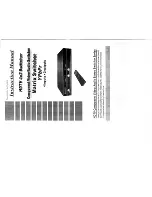
16
P
ROBLEM
S
OLVING
The Switch has been designed to aid you when detecting
and solving possible problems with your network. These
problems are rarely serious; the cause is usually a
disconnected or damaged cable, or incorrect configuration.
If this section does not solve your problem, contact your
supplier for information on what to do next.
Perform these actions first:
■
Ensure all network equipment is powered on.
■
Power each piece of network equipment off, wait about
5 seconds and then power each one on.
Check the following symptoms and solutions:
Power LED not lit.
Check your power adapter connection.
If there is still no power, you may have a faulty power
adapter which needs replacing with another OfficeConnect
power adapter.
Do not use any other power adapter
with the Switch.
Link between the Switch and another OfficeConnect
hub not working.
Check your connections; follow the
information given in the “Connecting OfficeConnect Units
to Your Switch” section on page 14. It is likely that an
Uplink/Normal switch is incorrectly set.
Alert LED continuously lit.
If the Alert LED is lit, there is a
problem with the network. Remove the port connections
one at a time, waiting a few seconds between each port. If
the Alert LED goes off, there is either a network loop or an
excessive amount of broadcast traffic on that port
connection:
Network loop — Examine your connections and remove the
loop. Each piece of equipment needs only one connection
to your Switch.
Excessive amounts of broadcast frames — Some pieces of
network equipment operate by sending out broadcast
frames regularly. Refer to the documentation that
accompanies the piece of network equipment.
If the Alert LED is still lit after removing all of your
connections, there may be a problem with your Switch.
Power it off, wait about 5 seconds and then power it on. If
the Alert LED comes back on continuously, contact your
supplier.
3C16734_Booklet.book Page 16 Tuesday, July 13, 1999 11:05 AM
















































